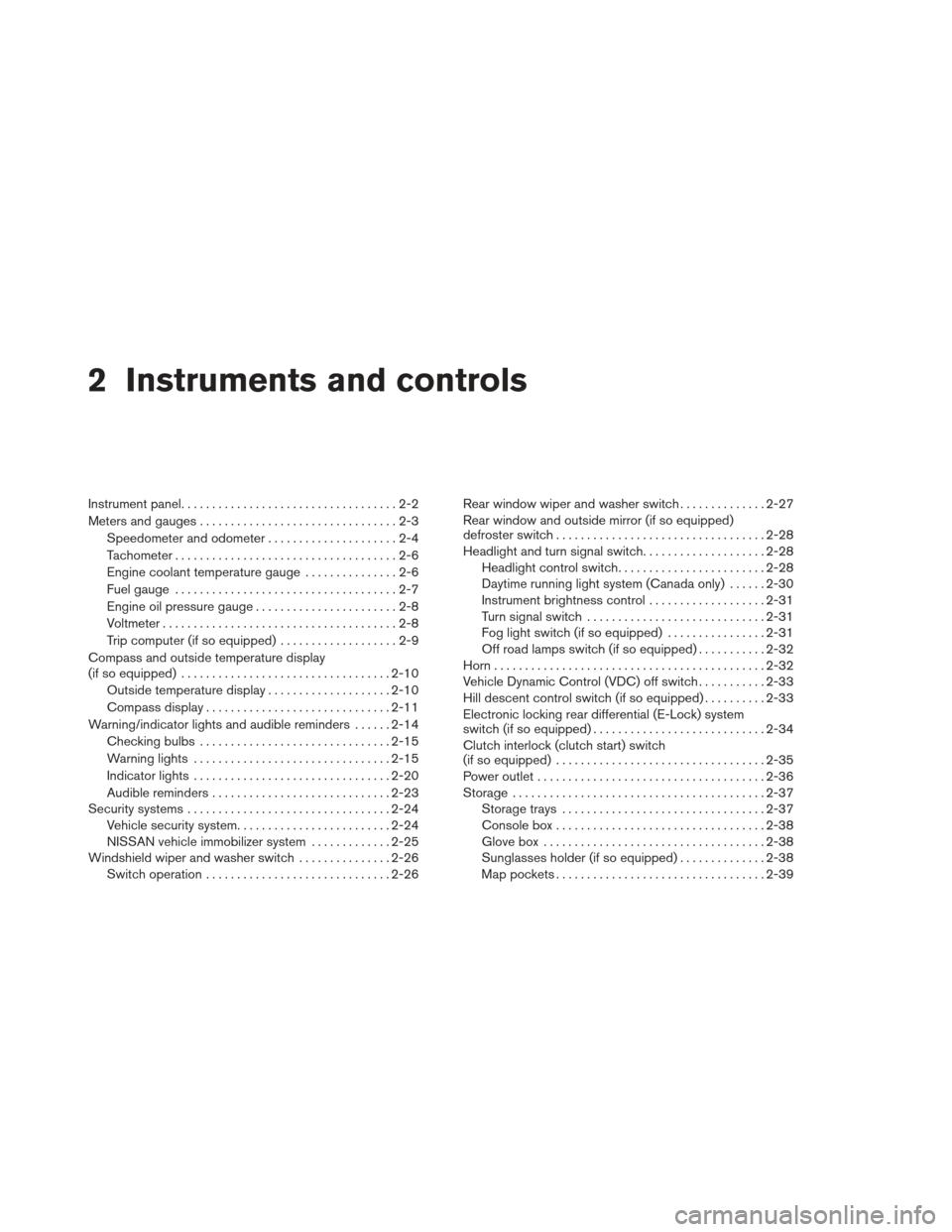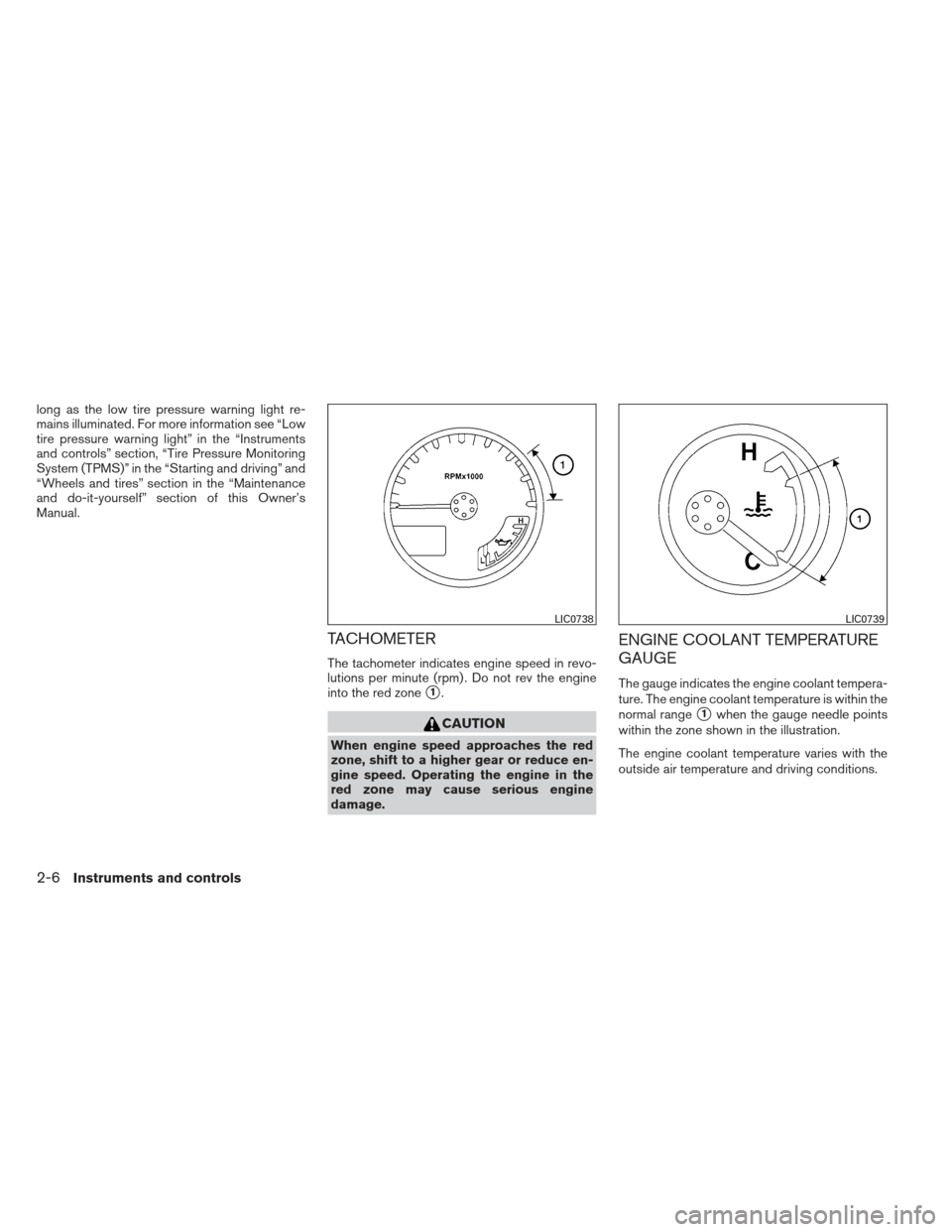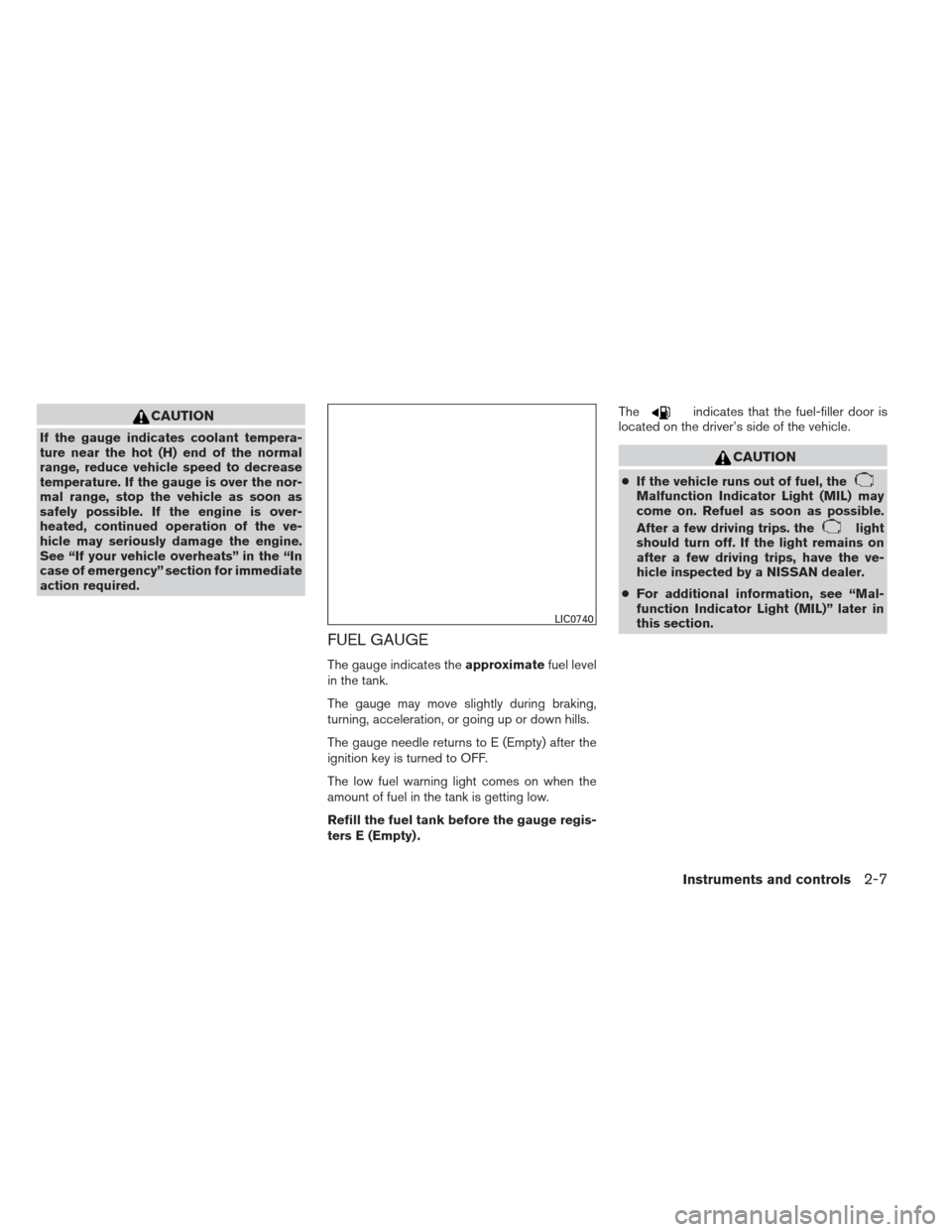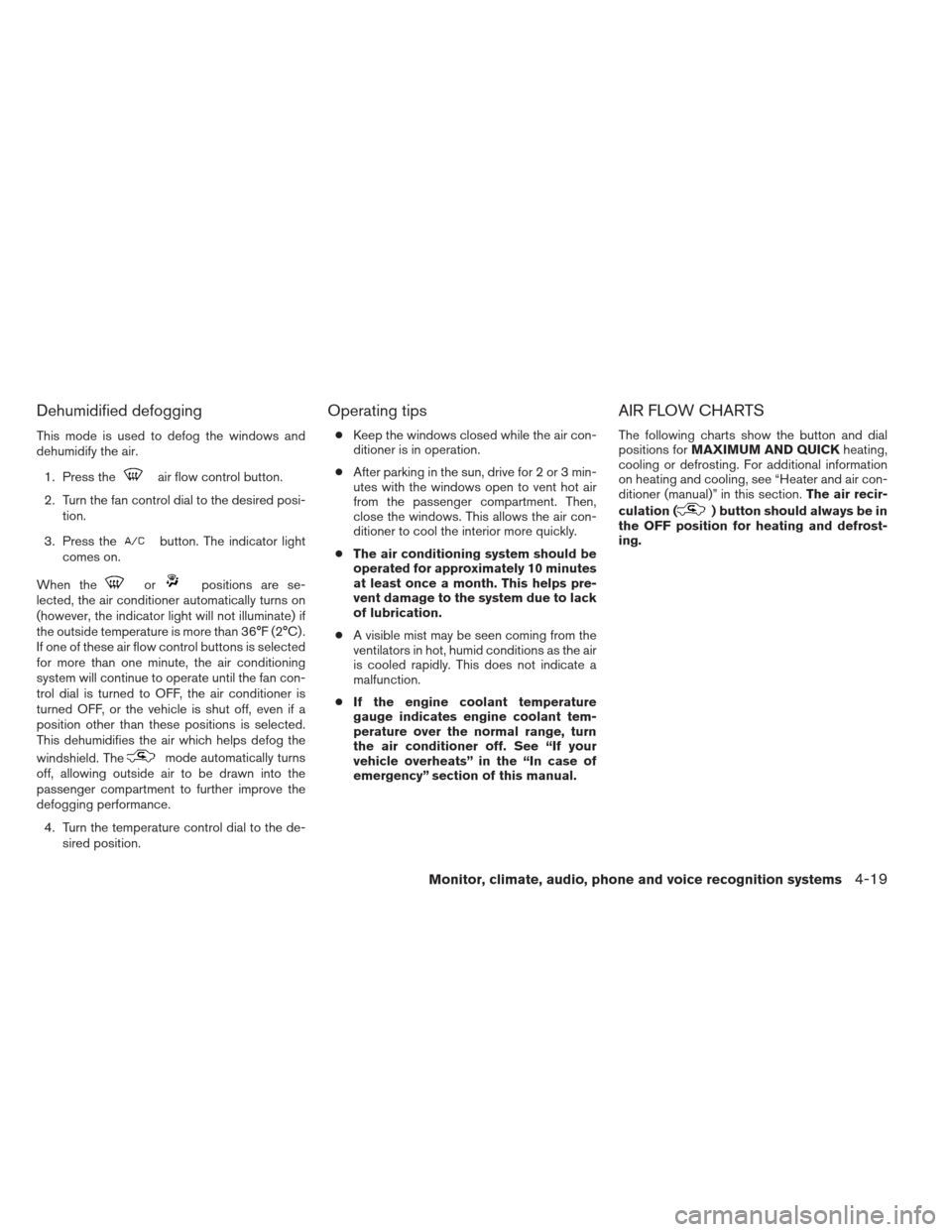Page 15 of 394
VQ40DE engine
1. Windshield-washer fluid reservoir(P. 8-14)
2. Fuse/fusible link box (P. 8-23)
3. Fuse and relay box (P. 8-23)
4. Engine oil filler cap (P. 8-9)
5. Engine oil dipstick (P. 8-9)
6. Brake fluid reservoir/Clutch fluid
reservoir (M/T model) (P. 8-13)
7. Air cleaner (P. 8-18)
8. Drive belt location (P.8-17)
9. Radiator cap (P. 8-7)
10. Power steering fluid reservoir (P. 8-12)
11. Battery (P. 8-14)
12. Engine coolant reservoir (P. 8-7)
See the page number indicated in paren-
theses for operating details.
LII0167
ENGINE COMPARTMENT CHECK
LOCATIONS
0-8Illustrated table of contents
Page 77 of 394

2 Instruments and controls
Instrument panel...................................2-2
Meters and gauges ................................2-3
Speedometer and odometer . . ...................2-4
Tachometer ....................................2-6
Engine coolant temperature gauge ...............2-6
Fuel gauge ....................................2-7
Engine oil pressure gauge .......................2-8
Voltmeter ......................................2-8
Trip computer (if so equipped) ...................2-9
Compass and outside temperature display
(if so equipped) .................................. 2-10
Outside temperature display . . ..................2-10
Compass display .............................. 2-11
Warning/indicator lights and audible reminders ......2-14
Checking bulbs ............................... 2-15
Warning lights ................................ 2-15
Indicator lights ................................ 2-20
Audible reminders ............................. 2-23
Security systems ................................. 2-24
Vehicle security system ......................... 2-24
NISSAN vehicle immobilizer system .............2-25
Windshield wiper and washer switch ...............2-26
Switch operation .............................. 2-26Rear window wiper and washer switch
..............2-27
Rear window and outside mirror (if so equipped)
defroster switch .................................. 2-28
Headlight and turn signal switch ....................2-28
Headlight control switch ........................ 2-28
Daytime running light system (Canada only) ......2-30
Instrument brightness control ...................2-31
Turn signal switch ............................. 2-31
Fog light switch (if so equipped) ................2-31
Off road lamps switch (if so equipped) ...........2-32
Horn ............................................ 2-32
Vehicle Dynamic Control (VDC) off switch ...........2-33
Hill descent control switch (if so equipped) ..........2-33
Electronic locking rear differential (E-Lock) system
switch (if so equipped) ............................ 2-34
Clutch interlock (clutch start) switch
(if so equipped) .................................. 2-35
P ower
outlet ..................................... 2-36
Storage ......................................... 2-37
Storage trays ................................. 2-37
Console box .................................. 2-38
Glove box .................................... 2-38
Sunglasses holder (if so equipped) ..............2-38
Map pockets .................................. 2-39
Page 80 of 394
15. Electronic locking rear differential(E-Lock) system switch
(if so equipped) (P. 2-34)
Hill descent control switch
(if so equipped) (P. 2-33)
Vehicle Dynamic Control (VDC) OFF
switch (P. 2-33)
16. Shift selector (P. 5-13)
17. 4WD shift switch (P. 5-27)
18. Climate controls (P.4-16, 4-23)
19. Hazard warning flasher switch (P. 6-2)
20. Ignition switch (P. 5-9)
21. Tilt steering wheel control (P. 3-12)
22. Off road lamps switch (if so equipped)
(P. 2-32)
23. Clutch interlock (clutch start) switch
(if so equipped) (P. 2-35)
24. Power outside mirror controls
(if so equipped) (P. 3-16)
See the page number indicated in paren-
theses for operating details.
1. Warning/indicator lights
2. Tachometer
3. Speedometer
4. Fuel gauge
5. Voltmeter 6. Odometer/Twin trip odometer/Trip
computer (if so equipped)
7. Engine oil pressure gauge
8. Engine coolant temperature gauge
WIC0911
METERS AND GAUGES
Instruments and controls2-3
Page 83 of 394

long as the low tire pressure warning light re-
mains illuminated. For more information see “Low
tire pressure warning light” in the “Instruments
and controls” section, “Tire Pressure Monitoring
System (TPMS)” in the “Starting and driving” and
“Wheels and tires” section in the “Maintenance
and do-it-yourself” section of this Owner’s
Manual.
TACHOMETER
The tachometer indicates engine speed in revo-
lutions per minute (rpm) . Do not rev the engine
into the red zone
�1.
CAUTION
When engine speed approaches the red
zone, shift to a higher gear or reduce en-
gine speed. Operating the engine in the
red zone may cause serious engine
damage.
ENGINE COOLANT TEMPERATURE
GAUGE
The gauge indicates the engine coolant tempera-
ture. The engine coolant temperature is within the
normal range
�1when the gauge needle points
within the zone shown in the illustration.
The engine coolant temperature varies with the
outside air temperature and driving conditions.
LIC0738LIC0739
2-6Instruments and controls
Page 84 of 394

CAUTION
If the gauge indicates coolant tempera-
ture near the hot (H) end of the normal
range, reduce vehicle speed to decrease
temperature. If the gauge is over the nor-
mal range, stop the vehicle as soon as
safely possible. If the engine is over-
heated, continued operation of the ve-
hicle may seriously damage the engine.
See “If your vehicle overheats” in the “In
case of emergency” section for immediate
action required.
FUEL GAUGE
The gauge indicates theapproximatefuel level
in the tank.
The gauge may move slightly during braking,
turning, acceleration, or going up or down hills.
The gauge needle returns to E (Empty) after the
ignition key is turned to OFF.
The low fuel warning light comes on when the
amount of fuel in the tank is getting low.
Refill the fuel tank before the gauge regis-
ters E (Empty) . The
indicates that the fuel-filler door is
located on the driver’s side of the vehicle.
CAUTION
● If the vehicle runs out of fuel, theMalfunction Indicator Light (MIL) may
come on. Refuel as soon as possible.
After a few driving trips. the
light
should turn off. If the light remains on
after a few driving trips, have the ve-
hicle inspected by a NISSAN dealer.
● For additional information, see “Mal-
function Indicator Light (MIL)” later in
this section.
LIC0740
Instruments and controls2-7
Page 164 of 394

Dehumidified defogging
This mode is used to defog the windows and
dehumidify the air.1. Press the
air flow control button.
2. Turn the fan control dial to the desired posi- tion.
3. Press the
button. The indicator light
comes on.
When the
orpositions are se-
lected, the air conditioner automatically turns on
(however, the indicator light will not illuminate) if
the outside temperature is more than 36°F (2°C) .
If one of these air flow control buttons is selected
for more than one minute, the air conditioning
system will continue to operate until the fan con-
trol dial is turned to OFF, the air conditioner is
turned OFF, or the vehicle is shut off, even if a
position other than these positions is selected.
This dehumidifies the air which helps defog the
windshield. The
mode automatically turns
off, allowing outside air to be drawn into the
passenger compartment to further improve the
defogging performance.
4. Turn the temperature control dial to the de- sired position.
Operating tips
●Keep the windows closed while the air con-
ditioner is in operation.
● After parking in the sun, drive for 2 or 3 min-
utes with the windows open to vent hot air
from the passenger compartment. Then,
close the windows. This allows the air con-
ditioner to cool the interior more quickly.
● The air conditioning system should be
operated for approximately 10 minutes
at least once a month. This helps pre-
vent damage to the system due to lack
of lubrication.
● A visible mist may be seen coming from the
ventilators in hot, humid conditions as the air
is cooled rapidly. This does not indicate a
malfunction.
● If the engine coolant temperature
gauge indicates engine coolant tem-
perature over the normal range, turn
the air conditioner off. See “If your
vehicle overheats” in the “In case of
emergency” section of this manual.
AIR FLOW CHARTS
The following charts show the button and dial
positions for MAXIMUM AND QUICK heating,
cooling or defrosting. For additional information
on heating and cooling, see “Heater and air con-
ditioner (manual)” in this section. The air recir-
culation (
) button should always be in
the OFF position for heating and defrost-
ing.
Monitor, climate, audio, phone and voice recognition systems4-19
Page 172 of 394
●If the engine coolant temperature
gauge indicates engine coolant tem-
perature over the normal range, turn
the air conditioner off. See “If your
vehicle overheats” in the “In case of
emergency” section of this manual.
AIR FLOW CHARTS
The following charts show the button and dial
positions for MAXIMUM AND QUICK heating,
cooling or defrosting. For additional information
on heating and cooling, see “Heater and air con-
ditioner (manual)” in this section. The air recir-
culation (
) button should always be in
the OFF position for heating and defrost-
ing.
WHA0775
Monitor, climate, audio, phone and voice recognition systems4-27
Page 248 of 394
Draining of coolant water.......................5-38
Tire equipment ................................ 5-38
Special winter equipment .......................5-38Driving on snow or ice
......................... 5-38
Engine block heater (if so equipped) .............5-39